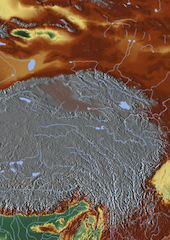Tibet and 21st Century Water Wars
How will the Tibetan Plateau determine the course of Asia’s future?
July 11, 2013

The crucial global role that Asia will play in the 21st century cannot be underestimated.
The pivot of global economic power is shifting east. Asia represents the new arena for analysis, power and influence.
The narrative of the coming Asian century is dominated by a variety of factors — rising economic power, demography, ecology, fierce resource competition, water and food supply and security, as well as increasing military expenditure.
In addition, Asia has the greatest number of geopolitical “hot spots” and nuclear powers.
In the latter context, the Tibetan Plateau stands out. Strategically located between the two Asian giants, China and India, the Tibetan Plateau and its surroundings have come to represent Asia’s most critical 21st century battleground.
Potentially, they may also be the world’s battleground.
The narrative of this century and of Asia will be written, to a very large extent, in terms of what is the “hottest geopolitical issue” — water security.
The Tibetan Plateau extends from the Hindu Kush in central Afghanistan, through Pakistan, India, Nepal, Bhutan and onto the borders of Myanmar.
The geopolitical significance of Tibet has been tremendous historically, too. It was invaded by Britain in 1904 for that reason.
Forty-five years later China’s Liberation occurred and, almost immediately afterwards, the People’s Liberation Army annexed Tibet in 1950-51.
For Mao Zedong, the strategic importance of Tibet was clear. It was fundamental to national security. The Tibetan Plateau acts as a major buffer zone and provides China with leverage over almost the entire Eurasian continent.
From a national security point of view, the vast barriers of the Tibetan Plateau shield China’s internal populace in the east from military aggression originating from the west.
This strategic importance was clearly manifested in the Sino-Indian War of 1962 — the only war in which the People’s Liberation Army has been successful so far! Losing Tibet would be seen as greatly weakening China strategically and a national humiliation.
Apart from its strategic location, the renewed importance of Tibet for China lies in its water riches. China has long been eyeing the water reserves of Tibet, especially during and since the period of Mao (1949-1976).
Located at a high altitude on an average of 4,500 meters, it is richly endowed with fresh water contained in its oxygen deprived vast glaciers and huge underground reservoirs.
It is in fact the largest repository of freshwater after the two poles, Arctic and Antarctic, thus claiming the sobriquet, the “third pole.” Many of the world’s greatest rivers flow out of the Tibetan Plateau — the Yellow River, Yangtze Kiang, Mekong, Salween, Sutlej and the Brahmaputra.
More important, in terms of human geography, almost half of the global population currently lives in the watershed of the Tibetan Plateau. This explains the enormous importance of Tibetan freshwater for China.
China, on the whole, is an extremely arid country. One quarter of the country consists of deserts.
China has severe water shortage challenges. At the same time, most of its rivers are either too polluted or are too silted to quench the thirst of 1.3 billion people.
The basic internal issue for China regarding water security is to transfer fresh water from the Tibetan Plateau in the country’s west to its industrial and populated corners in its north and east.
This has resulted in a spree of building dams, canals, irrigation systems, pipelines and water diversion projects.
As Brahma Chellaney points out in his seminal work, “Water: Asia’s Next Battleground,” China has created more dams in the last five decades than the rest of the world combined, largely in order to divert the flow of rivers from the south to its north and east corners.
The end result was the diversion of routes of various rivers originating in the Tibetan Plateau.
China considers such diversions to be an internal security matter.
But these inter-basin and inter-river water transfer projects in the Tibetan Plateau have tremendous consequences on other downstream countries that draw water from those rivers.
Thus, what was seen as a national concern for China in reality has vast external ramifications. Chinese policy so far has been to seek to minimize issues to be negotiated with its neighbors.
But diversion of rivers could boil into a hot conflict in the near future.
Water wars could largely destabilize not just the wider Tibetan region, but also all of Asia. Based on current trends, the question is not “how” and “why” such conflicts would arise, but “when”?
Today, countries surrounding the Tibetan Plateau in Southeast Asia, the Indian subcontinent and, of course, China are scrambling to build “mountains of concrete.”
For now, they are addicted to dam building for the purposes of power generation, water security, food security, livelihoods and national identity.
To give but one example, at present the biggest source of income to the economies of Nepal and Bhutan comes from hydropower development.
That reflects their strategic upstream location.
However, the country that has been most aggressive in this dam-building trend has been China.
China utilizes the rivers originating upstream in the Tibetan Plateau to build as many as 60 new dams to augment its demand for energy.
Electricity originating from these dams from the Tibetan Plateau finds its way to China’s large metropolises of Shanghai, Chongqing and Guangzhou.
However, China’s action to promote and preserve its national interest can have severe economic, social, political and environmental consequences in the downstream countries. These represent the most populous regions of the world.
The construction of dams on rivers originating in the Tibetan Plateau may seriously interrupt the water supply in downstream countries.
In addition, these constructions pose a grave threat to the regions’ biodiversity and environment. Located in a highly seismic zone, dam building also increases risks of catastrophic earthquakes affecting hundreds of millions.
Even though China claims to have the interests of these countries in consideration, it remains one of the only nations without any institutionalized water sharing agreement with downstream countries.
Lack of information sharing, transparency in building projects and data sharing with the affected states downstream remain a constant source of tension.
For instance, China is building three large hydropower dams on the upstream Yarlung Tsangpo River (in Tibet, which China has renamed the River Yarluzangbu).
Further downstream, it flows as the Brahmaputra into densely populated areas of India and Bangladesh. The great consequences of these dams are clear for all to see.
These dams could well interrupt the fresh water supply to northeastern India and Bangladesh. This is also a region where most of the people depend on the fresh water supply for livelihoods, agriculture and food.
India’s and Bangladesh’s combined population of over 1.3 billion is already edging past China’s. India alone is expected to surpass China’s population in just over a decade.
Whatever the merits of the current South-North Water Diversion Project, China’s multi-decade river rerouting plan at a cost of $62 billion, it will have severe environmental and water security consequences for its neighbors.
The Chinese ambition to go forward with such projects in the Tibetan Plateau is fueled by its “success” with the controversial Three Gorges Dam. And it is part of the legacy left behind by its past President Hu Jintao, a hydrological engineer by training.
Engineering pride aside, that project connected two of China’s most chronic problems — water and Tibet.
The northward rerouting of the Brahmaputra River to join the fast drying Yellow River with the construction of three dams in the Great Bend is bound to have significant geopolitical ramifications well beyond the typical issues in Sino-India relations.
Together, the pair represents around 40% of the global population.
Although India has more arable land than China, the Tibetan Plateau is the source of origin for most Indian rivers.
There has been a long lull in Sino-Indian tensions since the 1962 war between the two Asian giants. Today the two have “re-emerged” as relatively amicable great powers.
Their conflict potential has now shifted from territorial dispute to water security. That is not a reason for optimism.
Countries in Southeast Asia are also affected by China’s dam-building projects. China has built dams upstream on the Mekong River, whose water is shared downstream by Cambodia, Laos, Thailand and Vietnam.
Almost 60 million people in these countries depend on the Mekong River for fresh water, food income, health and, most important, for their national identity.
Any interruptions in their water supply could pose catastrophic threats to food security and greatly affect their rich biodiversity. Such consequences could result in tens of millions of environmental refugees.
All of which makes plain why the Tibetan Plateau is a global strategic epicenter. It may well determine whether the “Asian century” emerges as a variation on an earlier European theme or it traces its own peaceful trajectory.
As the 100th anniversary of World War I approaches, this question is much more than academic.
This article was co-authored by Jean-Pierre Lehmann, an emeritus professor of international political economy at IMD, in Lausanne, Switzerland. He is currently a visiting professor on the Faculty of Business and Economics at Hong Kong University.
Takeaways
The Tibetan Plateau provides China with leverage over almost the entire Eurasian continent.
The narrative of this century and of Asia will be written on the "hottest geopolitical issue" — water security.
China has long been eyeing the water reserves of Tibet.
Tibet is the largest repository of freshwater after the two poles. It is referred to as the "third pole."
Almost half the world's population currently lives in the watershed of the Tibetan Plateau.
A quarter of China is desert. India has more arable land than China but Tibet is its primary water source.
China remains one of the only nations without a water sharing agreement with downstream countries.
Authors

Nina Ninkovic
Nina Ninkovic is a water security expert at the Geneva School of Diplomacy.

Jean-Pierre Lehmann
Emeritus Professor of International Political Economy at the IMD Business School [Switzerland] Jean-Pierre Lehmann (1946-2017) was an emeritus professor of international political economy at IMD in Lausanne, Switzerland. He also served currently a visiting professor on the Faculty of Business and Economics at Hong Kong University. He was also a Contributing Editor at The Globalist, […]
Read previous

Coordinate Currencies, or Stagnate
July 10, 2013